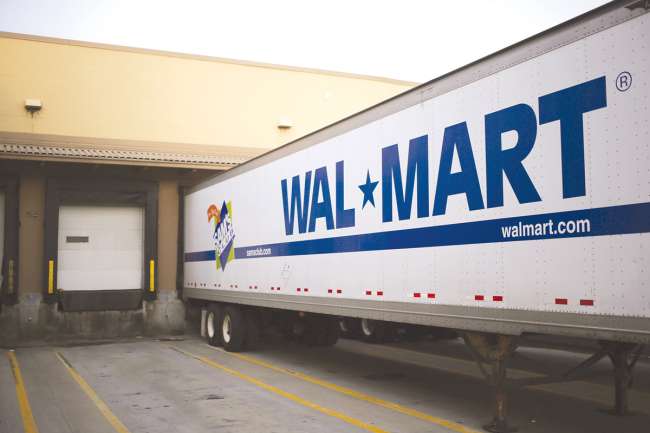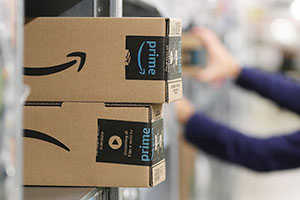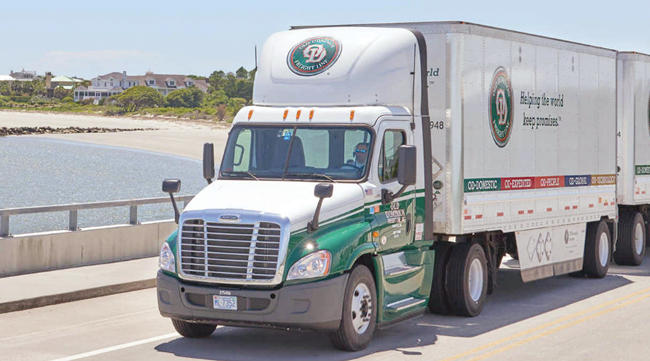On-Time, In-Full

[Stay on top of transportation news: Get TTNews in your inbox.]
To lure modern consumers who have come to expect instant gratification from the online shopping experience, retailers such as Walmart and Target and e-commerce giants such as Amazon.com have begun offering free one-day shipping as well as same-day delivery for a fee to those with premium subscriptions.
But to provide these aggressive delivery options, retailers have been placing increasingly stringent delivery windows on suppliers and their trucking companies.
Earlier this year, Walmart tightened the requirements of its “on-time, in-full” program. The company not only raised the bar for on-time delivery, it placed more emphasis on delivering in-full — meaning that everything ordered is in the trailer — by breaking it out as a separate measurable category.

►Fleets expand to keep up with e-commerce
►Top 100 Private interactive map
►Valley Proteins turns grease into gold
►Reducing emissions in shipping
Sector Rankings
Food Service | Grocery
Beverage
Petroleum/Chemical
Industrial Gases | Agriculture/Food Processing
Wholesale/Retail | Manufacturing Equipment Rental | Building Materials
Waste Management
Paper/Office Products
Construction
Health Care
Uniform Rental
Media & Entertainment
Now, suppliers and their trucking companies must meet both performance requirements, which could prove tricky at times when suppliers don’t have quite enough inventory.
To meet its in-full requirement, Walmart suppliers must have 95% of a general merchandise order and 97.5% of a food and beverage order in the trailer. For shipments to be considered on-time, the orders must arrive when they were scheduled. That means holding shipments until there’s enough inventory to meet the in-full requirement may no longer be an option.
The average on-time performance requirement for shipments under control of the retailer is 95%, compared with 87% for prepaid truckload and 70% for prepaid less-than-truckload.
Target, meanwhile, announced in June that online shoppers in 47 states can get items delivered on the same day by paying a flat fee of $9.99 per order. The Minneapolis-based retailer is using Shipt, a membership-based, same-day delivery platform it acquired in December 2017, to accomplish same-day delivery.
At the same time, Amazon has been working on shipping alternatives allowing customers to change the locations where orders can be delivered, including lockers, garages and hotel foyers.
Amazon also has started its own digital-freight brokerage platform at freight.amazon.com, offering full truckload as a “beta service” available in Connecticut, Maryland, New Jersey, New York and Pennsylvania.
According to Amazon Chief Financial Officer Brian Olsavsky, the company plans to “use all available levers” to accomplish the one-day delivery goal.

Amazon plans to one day achieve the one-day delivery goal. (Amazon)
All of these shipping options are designed to provide consumers greater choices, but for suppliers and their carriers, they can be double-edged swords depending on how their inventory deliveries are arranged.
“On-time, in-full deliveries are a symptom of a larger shift in the retail space,” said Rachal Snider Jordan, vice president of customer supply chain for logistics-services firm GlobalTranz. “Most retailers have developed their own vendor scorecard system, which outlays their individual on-time and fulfillment expectations.”
Requirements similar to Walmart’s OTIF program have become the norm for many retailers, she said. Target, for instance, charges a fee of 5% on late or inaccurate shipments.
“Retailers are under increasing pressure to meet shifting consumer expectations like increased demand for faster shipping, thanks to companies like Amazon,” Jordan said. “To maintain their growth pattern without spending millions in excess inventory and keep shelves full, [OTIF] delivery standards are essential.”
Although Walmart may be more transparent about its delivery requirements than other retailers, suppliers and their trucking companies should not use Walmart’s delivery performance requirements as their sole measurement, Jordan said. Their goal should be to ensure a dynamic and lean operation through innovation and making adjustments to meet the expectations of retailers no matter their size.
“Don’t expect this to be the last change from Walmart, either. They are going to continue to sharpen the pencil,” Jordan advised. “Many retailers have ‘just-in-time’ inventory turnover and are increasing demands of suppliers so that the second their last case is empty, a new one is at the door. [Suppliers] should imagine a 95% on-time minimum throughout the industry within the next five years and start building out a plan to deliver.”
Suppliers will need to be able to anticipate when and where capa- city changes will be needed to avoid additional costs, she added. “In response to this need for increased visibility and planning, we’re seeing a lot of technology innovation in the marketplace.

To meet sensitive delivery windows, Old Dominion aims to position inventory as close to customers as possible. (Old Dominion Freight Line)
Old Dominion Freight Line offers one such example of the use of technology innovation.
The LTL carrier, which operates 235 service centers throughout the United States, invests heavily in technology and IT services to maximize efficiency, according to Steve Hartsell, vice president of field sales at Old Dominion.
In dense urban markets, Old Dominion positions inventory using its extensive pickup and delivery fleet to deliver to multiple shipping points. The company’s goal is to position itself as close to customers as possible, Hartsell said. For must-arrive-by-date shipments, the company also assigns a customer service representative to act as a single point of contact for all details regarding those particularly time-sensitive loads.
“Through our guaranteed service, we reroute inventory through our network to ensure that it arrives at the specific date, time and location our customers need,” Hartsell said. “Should delivery windows shift, we can adjust in-transit thanks to our nationwide service center network and command center, which tracks shipments in real time.”
Old Dominion’s service centers use paperless docking to boost speed, and the carrier’s online portal enables customers to track their freight throughout the delivery process, he said. “We’re also expanding mobile-optimized applications so our customers can track their shipments on the go.”
T.J. O’Connor, chief operating officer for YRC Worldwide and president of YRC Freight, its national LTL division, said coordination and communication are critical so that pickups, transit times and special handling needs can be clearly understood among all parties.

T.J. O'Connor.
“For example, if we arrive and a pickup is not ready, or isn’t loaded properly, or the paperwork isn’t ready, it can lead to delays that impact overall service performance and risk chargebacks,” O’Connor said. “To help build and maintain relationships, we use an onboarding process with retail clients to streamline and identify potential challenges before our supply chain engagement begins.”
Cathy Morrow Roberson, founder and head analyst at Logistics Trends & Insights, said there’s another reason why retailers are tightening their delivery window requirements.
As the Trump administration initiated tariffs against China beginning last year, shippers began importing more goods before the tariffs went into effect. A glut of imported goods resulted in historically low vacancy rates at warehouses and logistics spaces in and around the greater Los Angeles area, she said.
Even though suppliers and retailers might have a glut of inventory to draw upon, and even though the capacity crunch that existed last year largely has eased, Roberson cautioned shippers and retailers not to bully their carriers into accepting difficult and unprofitable contract conditions.

Cathy Roberson.
“To be shippers of choice, suppliers will have to work with their transportation partners, whether that’s by rail, plane or truck,” Roberson said. “Partners need to be just that, partners. That includes understanding each other’s business and their needs.”
Dan Sanker, CEO and founder of CaseStack Inc., said trucking companies and operators also need to understand what may be behind a retailer’s motivation for setting delivery conditions.
Carriers may erroneously believe that retailers assess fees and penalties for missed delivery windows as some way to offset costs or raise revenue. Shippers simply may be raising the bar on service levels to get more value from their supply chains, he said.
CaseStack, which was purchased by intermodal firm Hub Group in November 2018, offers freight consolidation for companies that sell consumer packaged goods to large retailers.
Sanker estimated that penalties paid by carriers for missed deliveries average 1% of revenue for consumer product goods.
With the right tools, freight consolidation can boost efficiency, particularly as retailers require more stringent delivery requirements, he said. Rather than filling a truck and trailer with only several pallets and running it half empty to one location, carriers can combine shipments so that the truck and trailer can make deliveries to several locations with a full or nearly-full load.
Zipline Logistics, a Columbus, Ohio-based provider of third-party logistics services, outlined just that scenario in a white paper.
The report discusses two options for suppliers when working with retailers on arranging product delivery: customer pickup and delivered cost pricing. It shows how a middle-market snack food manufacturer based in central Ohio consolidated loads going to several different retailers and realized vastly improved margin per unit while still meeting the retailers’ must-deliver-by date and on-time, in-full requirements.
“The most beneficial option isn’t always obvious,” Zipline cautioned. “Many [suppliers] assume that letting retailers manage the process will be the best choice because it is seemingly less work and pricing is more predictable. However, taking control of transportation can equate to immediate operational savings, more control and an increase in product margin.”
Zipline found that the potential for problems starts when retailers begin to dictate pickup times.
“Manufacturers can lose control and retailers can indirectly make decisions about a brand’s production schedule and operations,” the report said. “Customer pickups are scheduled based on what’s most convenient and least expensive for the retailer, which can be disruptive for a manufacturer’s dock and production planning.”
Daniel P. Bearth contributed to this story.


